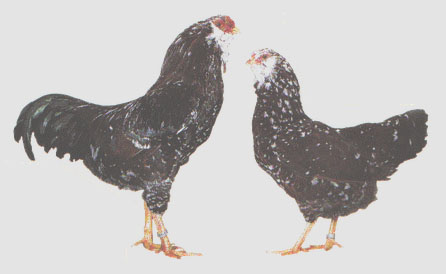

The Russian Orloff Society of USA & Canada

Russian Orloff hen at Darwin Museum dated 1889

Feather fromRussian Orloff hen at Darwin Museum dated 1889. Gifted to ROUSCA by Alexander Korolev at National in UK 2016.
Russian Orloff
Breed History
The breed is said to have been created in the late 18th century by Count Alexei Orloff (1737- 1808) by crossing chickens from Gilan, a province in Iran, with local cold-hardy breeds from Russia. The Gilan, known prior to 1774, historically went by the name Chilanskaia, and was thought to have genetic origins in India or Asia. There is speculation on what the genetic makeup of the Gilan is, but also, what else Count Orloff had used to create his Russian Orloffs. With possibilities of Malay or Old English game being used, other speculations have also arisen around the Polish or even the Bearded Thurington from Belgium. The age of the breed itself makes it extremely hard to know all that was used coupled with the lack of documentation we have going back to that time.
With no one historian or book in agreement, more genetic research is needed to determine the true makeup and background of the Russian Orloff before making further speculations.
They are known for their dual purpose of both eggs and meat, laying an estimated 180-200 light brown or tinted eggs per year and large, but slow growing, carcasses. They were also bred specifically as winter layers; a trait prized in northern regions with shorter amounts of daylight. Kept by backyard enthusiasts and hobbyists alike for their striking upward stance and “game” appearance, the Spangled variety is the best known, but they also come in a range of colors like Black, White, Cuckoo, Mottled, and Mahogany. With small or non-visible waddles, raspberry comb, and short yellow beak, the Russian Orloff is built to stand up to the colder temperatures. They are admired for their long clean, yellow legs, full beard and muffs, coupled with striking yellow or amber eyes, which appear Hawk-like under a heavy brow.
Not seen in exhibition until 1881 in Moscow, Honorary member of the Russian Poultry Breeders Society S.N. Khudepov wrote in 1901, “The Orloff has only been bred here, in Russia for a long time. We, Russians, are familiarizing Europe and America with the beautiful breed for the first time”. And famous breeder I.I. Abozin in his book “Poultry Yard” wrote, “A height of good specimens is quite big. At the exhibition in 1881, the weighing showed that some cocks weighed eleven pounds and hens – 7-8 pounds”.
While by the 20'th century the Russian Orloff had almost disappeared from farmyards in their motherland, they had reached the hands of enthusiasts in Western Europe and became quite popular in Austria, Germany, and England around 1911-12. By 1915 the number of breeders in England became so large that a club was developed and the productivity of the Orloff eggs increased to 200 a year. (Average remains 160-180)
It was once thought that the Russian Orloff had been accepted by the American Poultry Association into their Standard of Perfection, and simply fell out of favor. It has since come to light that the November of 1872, Volume I, No. 11 of Poultry World, the month's featured breed was the Black Russian Fowl. Their name later was changed from Black Russian Fowl to just “Russian’s”, which further added to the confusion surrounding the issue. Russian Orloffs were also said to have reached Germany and the UK 1911, which would likely put them in the hands of the American’s after that date. By referencing the last known accepted description of the “Russians” in APA literature, along with the illustration of the Black Russian Fowl in the Poultry World article, one can concur that that they were clearly a different breed entirely than the Russian Orloff.
While we don’t have documentation on when or how the Russian Orloff arrived in the North America, historically we do have an article from Poultry Tribune- Volume 27- Page 65 (1921) which references Russian Orloff in several poultry yards and winning blue ribbons in Chicago and New York. The Poultry Item dated 1919 contains an ad selling Mahogany Orloff out of Georgia describes them as a new arrival to America.
This would all mean that the Russian Orloff has never been an accepted breed with the American Poultry Association, and that such an old breed is far overdue that privilege.
With their long history and diligent work of breeders across the globe to preserve these birds, the Russian Orloff has not faded away to be a breed only for the history books. This regal breed is on the cusp of something wonderful……..
the return of the Russian Orloff.


Orloff Bantam
The following history of the Bantam can be found in the German Journal "Poultry Market"
http://www.vzv.de/Fachartikel/Artikel/zwerg-orloff.htm
Only after Dr. Ranft from Upper Helmsdorf Dresden in 1910 again organized a new import from Russia, the breakthrough in Germany. 1912 Special club was established, chaired by Dr. Ranft took over. From this time we took the race steeply, despite the war, because the breeder hatching eggs and breeding animals continuously offered and made a lot of advertising in the journals for this breed. 1919 was Dr. Ranft to an active fellow, Rudolf Barth from Schmölln in Saxony, resigned as chairman from. Barth was the one who already started in the early 20s with the dwarfing the Orloff, which he would not come quite so advanced as he gathered enough cobreeders around. Even at that time the demand for dwarfs not as great as later after the 2nd World War. In addition, the farms had disappeared from before the 2nd World War to the end. After Wandelts "Handbook of Bantams races", in 1998, it should have been a single tap, with the Otto Squarr 1947 breeding resumed and crossed with different breeds.
In East Germany, there was again Rudolf Barth, who began with the dwarfing, and one can only marvel at what has been created in 50 years. Barth was also often the breeding evidence were in various magazines, so breeders were based on the somewhat difficult breeding work under. One-layer, they ennoble in the form and in the head to a dwarf of the future. In 1961 Barth advised in an article that one should never Lock other breeds, but go via numerous offspring and breed equitable selection. Only by strengthening the features you could create lasting a race. Ongoing crossbreeding bring at some point nothing - they only bring trouble.
The dwarf-Orloff actually represent a successful breeding combination of militant robustness and yet quite tame and affectionate creatures to their owners, what this breed very sufficient for the benefit.
Orloff Bantam are recognized in the USA by the American Bantam Association (ABA). There are two varieties in the USA, Spangled and White. They are even more rare than the Large Fowl counterpart with only less than 10 breeders with the Spangled variety and a few breeders with the white variety . The orloff Bantam is on the rise in popularity among Orloff keepers and inclusive a few more breeders working on increasing the numbers of the White variety.


